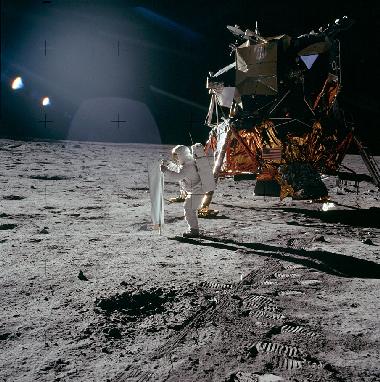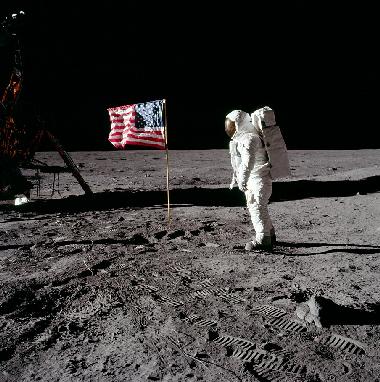-
 Bruce McCandless (CAPCOM)
Bruce McCandless (CAPCOM)
-
This is Houston. We can see Buzz's right hand. It is somewhat out of focus. I'd say we were focusing down to probably—oh, about 8 inches to a foot behind the position of his hand when he was pulling out the cable.
-
 Buzz Aldrin (LMP)
Buzz Aldrin (LMP)
-
And, we'll probably need a little *** distance *** back location *** television camera.
-
 Buzz Aldrin (LMP)
Buzz Aldrin (LMP)
-
Neil, look at the minus Y-strut, the direction of travel there *** travel from right to left.
-
 Buzz Aldrin (LMP)
Buzz Aldrin (LMP)
-
This one over here underneath the ascent engine where the probe first hit—the minus-Y probe first hit.
-
 Buzz Aldrin (LMP)
Buzz Aldrin (LMP)
-
Forty, 50 feet. Why don't you turn around and let them get a view from there and see what the field of view looks like?
-
 Bruce McCandless (CAPCOM)
Bruce McCandless (CAPCOM)
-
Neil, this is Houston. The field of view is okay. We'd like you to aim it a little bit more to the right. Over.
-
 Buzz Aldrin (LMP)
Buzz Aldrin (LMP)
-
Okay. That's all the cable we have. *** not going out. I'll start working on the solar wind —
-
 Bruce McCandless (CAPCOM)
Bruce McCandless (CAPCOM)
-
A little bit too much to the right. Can you bring it back left about 4 or 5 Degrees?
-
 Neil Armstrong (CDR)
Neil Armstrong (CDR)
-
Let's try it like that for a while. I'll get a couple of panoramas with it, here.
-
 Bruce McCandless (CAPCOM)
Bruce McCandless (CAPCOM)
-
Roger. You look okay as far as distance goes, Neil. And we'll line you up again when you finish the panorama. Now you're going too fast on the panorama sweep. You're going to have to stop, or -
-
 Neil Armstrong (CDR)
Neil Armstrong (CDR)
-
I haven't stopped—I haven't set it down yet. That's the first picture in the panorama. Right there.
Expand selection up Contract selection down Close -
 Neil Armstrong (CDR)
Neil Armstrong (CDR)
-
Okay. Now, this one is right down front, straight west. And I want to know if you can see an angular rock in the foreground.
-
 Bruce McCandless (CAPCOM)
Bruce McCandless (CAPCOM)
-
Roger. We have a large angular rock in the foreground, and it looks like a much smaller rock a couple of inches to the left of it. Over.
-
 Neil Armstrong (CDR)
Neil Armstrong (CDR)
-
All right. And then on beyond it about 10 feet is an even larger rock that's very rounded. That rock is about—The closest one to you is about sticking out of the sand about 1 foot. And it's about a foot and one half long, and it's about 6 inches thick, but it's standing on edge.
-
 Neil Armstrong (CDR)
Neil Armstrong (CDR)
-
This is straight south.
Expand selection down Contract selection up -
 Neil Armstrong (CDR)
Neil Armstrong (CDR)
-
Roger. The little hill just beyond the shadow of the LM is a pair of elongate craters about—probably the pair together is about 40 feet long and 20 feet across, and they're probably 6 feet deep. We'll probably get some more work in there later.
-
 Buzz Aldrin (LMP)
Buzz Aldrin (LMP)
-
And, incidently, you can use the shadow that the staff makes to *** getting it perpendicular ***
-
 Buzz Aldrin (LMP)
Buzz Aldrin (LMP)
-
Some of these small depressions *** tend to sink—oh, maybe 2 or 3 inches. *** suggest exactly what the Surveyor pictures showed when they pushed away a little bit. You get a force transmitted through the upper surface of the soil and about 5 or 6 inches of bay breaks loose and moves as if it were caked on the surface, when in fact it really isn't.
-
 Neil Armstrong (CDR)
Neil Armstrong (CDR)
-
I noticed in the soft spots where we had footprints nearly an inch deep that the soil is very cohesive and it will retain a—will retain a slope of probably 70 degrees along side of the footprints.
-
 Bruce McCandless (CAPCOM)
Bruce McCandless (CAPCOM)
-
Roger. The EVA is progressing beautifully. I believe they are setting up the flag now.
-
 Bruce McCandless (CAPCOM)
Bruce McCandless (CAPCOM)
-
I guess you're about the only person around that doesn't have TV coverage of the scene.
-
 Bruce McCandless (CAPCOM)
Bruce McCandless (CAPCOM)
-
Yes, indeed. They've got the flag up now and you can see the stars and stripes on the lunar surface.
-
 Buzz Aldrin (LMP)
Buzz Aldrin (LMP)
-
That's good. See if you can pull that end off a little bit. Take that end up a little.
-
 Buzz Aldrin (LMP)
Buzz Aldrin (LMP)
-
I'd like to evaluate the various paces that a person can *** traveling on the lunar surface. I believe I'm out of your field of view. Is that right, now, Houston?
Spoken on July 21, 1969, 3:31 a.m. UTC (55 years, 4 months ago). Link to this transcript range is: Tweet


